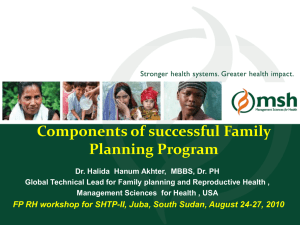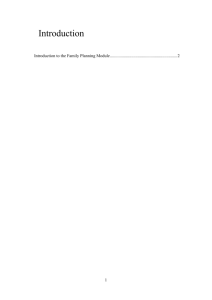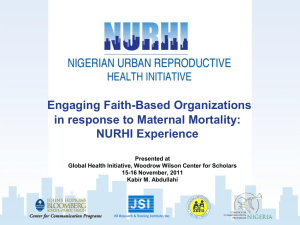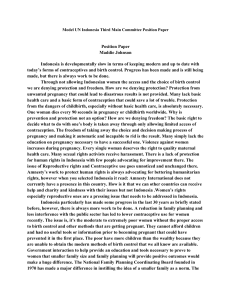2. Family Planning Service Delivery and Programme Management
advertisement
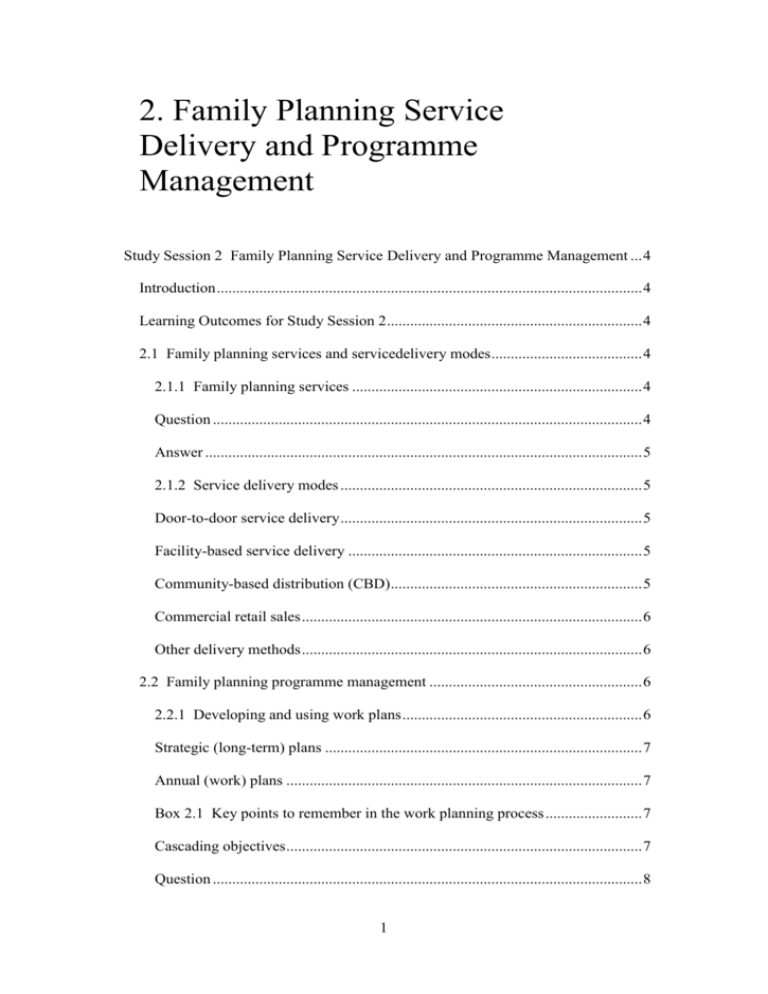
2. Family Planning Service Delivery and Programme Management Study Session 2 Family Planning Service Delivery and Programme Management ... 4 Introduction .............................................................................................................. 4 Learning Outcomes for Study Session 2 .................................................................. 4 2.1 Family planning services and servicedelivery modes ....................................... 4 2.1.1 Family planning services ........................................................................... 4 Question ............................................................................................................... 4 Answer ................................................................................................................. 5 2.1.2 Service delivery modes .............................................................................. 5 Door-to-door service delivery .............................................................................. 5 Facility-based service delivery ............................................................................ 5 Community-based distribution (CBD) ................................................................. 5 Commercial retail sales ........................................................................................ 6 Other delivery methods ........................................................................................ 6 2.2 Family planning programme management ....................................................... 6 2.2.1 Developing and using work plans .............................................................. 6 Strategic (long-term) plans .................................................................................. 7 Annual (work) plans ............................................................................................ 7 Box 2.1 Key points to remember in the work planning process ......................... 7 Cascading objectives ............................................................................................ 7 Question ............................................................................................................... 8 1 Answer ................................................................................................................. 8 Definitions of objectives and targets.................................................................... 8 Box 2.2 SMART objectives ................................................................................ 8 Targets.................................................................................................................. 9 Box 2.3 Examples of SMART targets ................................................................ 9 Developing monthly work plans .......................................................................... 9 Summarising activities in a Gantt chart ............................................................. 10 2.2.2 Monitoring and evaluation ....................................................................... 10 Monitoring ......................................................................................................... 10 Box 2.4 Common performance indicators for a family planning programme .. 11 Evaluation .......................................................................................................... 12 2.2.3 Managing contraceptive supply ............................................................... 12 Record keeping and reporting ............................................................................ 12 Types of recording forms ................................................................................... 12 Inventory control system.................................................................................... 13 Assessing your supply status ............................................................................. 14 Question ............................................................................................................. 15 Answer ............................................................................................................... 15 2.3 Family planning programme communications ............................................... 15 Question ............................................................................................................. 15 Answer ............................................................................................................... 15 Summary of Study Session 2 ................................................................................. 16 Self-Assessment Questions (SAQs) for Study Session 2 ...................................... 17 SAQ 2.1 (tests Learning Outcome 2.2) .............................................................. 18 Answer ............................................................................................................... 18 2 Case study 2.1 The demographic and health situation in kebele Y .................. 18 SAQ 2.2 (tests Learning Outcomes 2.1 and 2.3) ............................................... 18 Answer ............................................................................................................... 19 SAQ 2.3 (tests Learning Outcome 2.3) .............................................................. 20 Answer ............................................................................................................... 20 SAQ 2.4 (tests Learning Outcome 2.3) .............................................................. 21 Answer ............................................................................................................... 21 SAQ 2.5 (tests Learning Outcome 2.3) .............................................................. 21 Answer ............................................................................................................... 21 SAQ 2.6 (tests Learning Outcome 2.4) .............................................................. 21 Answer ............................................................................................................... 22 SAQ 2.7 (tests Learning Outcome 2.5) .............................................................. 22 Answer ............................................................................................................... 23 3 Study Session 2 Family Planning Service Delivery and Programme Management Introduction Providing effective family planning services which address the needs of the community is essential. Therefore, service delivery strategies need to be tailored to reach populations in different locations, such as urban areas, rural towns, villages and remote areas. The most common family planning service delivery approaches comprise health facilities, health posts, health centres, hospitals, and communitybased distribution, which includes commercial retail sales, door-to-door service delivery, and workplace distribution. Family planning programme management is about finding the most effective way to carry out activities related to family planning services, using appropriate human, material, financial and timely resources to reach set targets. In this study session, you will learn about the most commonly used family planning service delivery strategies practised in Ethiopia, and fundamental aspects of family planning programme management, including planning, monitoring and evaluation. Learning Outcomes for Study Session 2 When you have studied this session, you should be able to: 2.1 Define and use correctly all of the key words printed in bold. (SAQ 2.2) 2.2 Describe the category and function of each service delivery approach. (SAQ 2.1) 2.3 Explain how you would exercise the planning, monitoring and evaluation processes of the family planning programme. (SAQs 2.2, 2.3, 2.4 and 2.5) 2.4 Describe the process of managing contraceptive supplies. (SAQ 2.6) 2.5 Explain how to promote the family planning programme in your community through good communication. (SAQ 2.7) 2.1 Family planning services and servicedelivery modes 2.1.1 Family planning services Question 4 As a service provider you need to be able to describe family planning services. From your experience what are family planning services? Answer Family planning services are educational and comprehensive medical or social activities which enable individuals and couples to determine freely the number and spacing of their children, and to select the means by which this may be achieved. The service includes education, information, counselling, provision of contraceptive methods and referrals. End of answer In Ethiopia, all categories of public health facilities provide family planning services on a daily basis by integrating them with other maternal and child health services. Generally, clients are not asked to pay for their contraceptives. They can get any service free of charge at public health institutions. 2.1.2 Service delivery modes Door-to-door service delivery A door-to-door service providing family planning packages at household level is carried out by Health Extension Practitioners. The service includes education, counselling and the provision of contraceptive methods, such as oral pills, condoms and injectables. This approach started with the establishment of the Health Extension Programme and has been cost-effective, and the preferred way to reach the majority of people in their homes. Facility-based service delivery A facility-based service delivery approach provides family planning services in Ethiopia through public health centres and hospitals. The major advantage of using this approach is that it can provide medically complex methods, such as IUCDs, hormonal implants and sterilisation. This approach works well for those living close to any of these health facilities. Community-based distribution (CBD) In areas that do not have any type of health facility nearby, family planning services may be made available through community-based distribution or CBD programmes. In this approach, CBD workers, usually village women, are trained to educate their neighbours about family planning and to distribute certain contraceptives. In their training, the CBD workers learn the basic concepts of family planning, how each method must be used, what the precautions and side effects are for each method, and how to keep simple records and report the information to their supervisors. CBD programmes usually distribute condoms; some also provide pills 5 and spermicides. In Ethiopia, this programme has now been replaced by the Health Extension Programme. Commercial retail sales In both urban and rural areas, if people are willing to obtain contraceptives from sources outside the healthcare system, commercial retail sales (sometimes called social marketing) can make some contraceptive methods very accessible. In these approaches, contraceptives, such as oral contraceptive pills, condoms and injectables, are sold at reduced, subsidised prices in pharmacies, from market stalls, and so on. A good example of this is DKT-Ethiopia. When a commercial retail sales approach is used, the retailers are often the customers’ only source of information about the products. These retailers should be given training in basic information about the products, and how to refer people who have problems with a contraceptive. Other delivery methods A number of other service delivery methods have been used. Some companies provide family planning services during certain hours at the workplace. Although generally at a higher cost, family planning services are often available from private for-profit healthcare providers. Other approaches involve training paramedics, pharmacists, traditional birth attendants, midwives, traditional healers and outreach workers to provide family planning services. 2.2 Family planning programme management Family planning is not separate, but an important integral part of other health programmes. The planning, implementation, monitoring and evaluation processes of all health programmes, including family planning, are very similar and integrated. In this section, you will learn the general concepts of the planning, monitoring and evaluation processes, and their application to the family planning programme. 2.2.1 Developing and using work plans A work plan is a document developed by the manager and staff, which lists all planned activities, the date on which they will occur or by which they will be accomplished, the resources they will require, and the person who is responsible for carrying them out. Such a document is a valuable tool for efficient and effective programme implementation, and should be used regularly and consistently as a monitoring tool at all levels. Basically, there are two types of plans: 1. the strategic (long-term) plan 2. the annual (work) plan. 6 Strategic (long-term) plans A strategic plan is a well-developed document that determines what an organisation intends to be in the future, and how it will get there. It is the process by which the organisation assesses its current situation and decides how to scale up to achieve its vision. Strategic planning is the way in which it directs its efforts and resources towards what is truly important for the sector. Strategic planning is carried out at all levels. Annual (work) plans Work plans (also known as operational plans) are distinguished from long-term plans in that they show how the broader objectives, priorities and targets of the strategic plan will be translated into practical activities, which will then be carried out over a much shorter time period (anywhere from a week to a year). However, there should be complete harmony between the strategic objectives and the annual targets. The annual plan is sometimes divided into two: the core and the comprehensive plan. The core plan is the summarised form of a plan which mainly focuses on annual targets, major objectives, and major activities, while the comprehensive plan deals with detailed activities, including time of execution and cost. It can be cascaded to monthly, weekly and daily tasks. Note that, in the Ethiopian health sector context, currently all health services and programmes are integrated and harmonised, so there is no room for parallel or vertical plans. In the planning process, you need to ensure that family planning is integrated into other health programmes. Look at Box 2.1 for a better understanding of the work planning process; also refer to the Health Management, Ethics and Research Module. Box 2.1 Key points to remember in the work planning process To get the greatest benefit from work plans and the work planning process, you need to understand: the steps in the work planning process and who should be involved how to develop an annual work plan how an integrated and aligned annual work plan should be linked with monitoring and evaluation techniques that can be used to design integrated work plans for individual service delivery sites or staff members the benefits of work planning, as well as the importance of keeping the process flexible to respond to changes throughout the course of the programme. Cascading objectives 7 One way to develop short-term work plans is to divide the yearly objectives into quarterly or monthly targets, so that detailed activities are identified and costed. To determine these targets, begin by looking at the yearly objectives. Question Your health post, in collaboration with the woreda Health Office, has set objectives to provide family planning information and education to 1,000 potential acceptors in your kebele during the first year of service delivery. How can you cascade this into short-term targets? Answer In this case, first divide the 1,000 potential acceptors by 12 months to get a monthly target for that site. Next, divide the number of potential acceptors to be visited each month by the number of Health Extension Practitioners at the service site, so that each Health Extension Practitioner will know how many people she will need to visit each month. Then, list down all possible activities that can be executed during the period and who would be responsible for each activity. Remember that this target can be further divided by the number of working days per month and put on a calendar, so that each Health Extension Practitioner will have a work plan to use on a daily basis. End of answer In this way, you can break down large overall objectives into smaller, more manageable units that enable you to develop a monthly work plan more easily, and to distribute the workload more equitably. Definitions of objectives and targets Although there are many definitions for objectives and targets, for the purposes of this discussion and the examples shown here, the distinction between objectives and targets is defined as follows. An objective shows the anticipated results of the work conducted at one or more service delivery sites, and reflects the impact or changes that are expected in the population covered by this programme. Objectives should be SMART (see Box 2.2). and refer to the measurable results that are expected in a designated population within a specified period of time Usually there will be several objectives relating to one programme goal. Box 2.2 SMART objectives An example of an objective: To recruit 5,000 new acceptors in 10 kebeles by the end of the first year. 8 SMART is not a word, but an acronym (or combination of initial letters) representing: S Specific M Measurable A Achievable R Reliable T Time bounded. Accordingly, the above objective is SMART because it is specific to recruiting, measurable in terms of recruiting 5,000 new acceptors, achievable and reliable, as it can be executed within a given period of time, that is by the end of the first year. Targets Targets restate programme objectives for service delivery workers in numerical terms. They state the expected results and/or the intended activities of each service delivery component of the programme over a short time period, such as a quarter (three months), one month, or a week. Look at Box 2.3 for some examples of set targets. Keep in mind that targets serve three major purposes: Planning a programme. Motivating staff towards achievement. Guiding the monitoring and evaluation process. Box 2.3 Examples of SMART targets An example of an annual target for a specific service delivery site: To achieve an average of 83 new acceptors per month over the next 12 months in the kebele. An example of an annual target for a supervisor: To conduct supervisory visits to 10 Health Extension Practitioners each month of the year. An example of a monthly target for Health Extension Practitioners: To provide information and education to 400 couples in three communities over the next month. An example of a monthly target for Health Extension Practitioners: To locate and interview 15 clients each month who have dropped out of the programme in order to find out the reason why they have dropped out. Developing monthly work plans Monthly work plans should be developed and used at all levels of a programme or organisation. They are particularly useful for Health Extension Practitioners and supervisors. The activities in work plans are based on the annual plan, which has been developed at woreda level, but also includes more detailed information on activities, such as which villages and households are to be visited, the timing of 9 these visits, and the dates of the supervisory visits, holidays, self-assessment sessions and training. Summarising activities in a Gantt chart Once the work plan is completed, it is important to draw up a summary chart. This provides an important reference which can be used by all staff members, and communicates in a concise way what the project will do and when it will do it. This summary is called a Gantt chart and you can see an example in Table 2.1. Table 2.1 Sample Gantt chart with months marked in the Ethiopian calendar (EFY is the Ethiopian Fiscal Year). Family planning implementation schedule for EFY 2003, X health post, Y woreda. Responsible Target Activity Implementation Period Rem person Ham Neh Msk Tikm Hid Tahs Tir Yek Meg Miaz Gin Sene In Provide collabo information a X X X Demeshi with lo and advice NGOs b X X X X X Kolole c X X X Feyise A Gantt chart typically includes the following components: A column that lists major activities. Columns that mark a fixed period of time (days, weeks, months, years), showing when the activities will occur. A column that lists the person or people responsible for completing the activity. 2.2.2 Monitoring and evaluation Monitoring Monitoring is a process by which priority data and/or information is routinely collected, analysed, used and disseminated to see progress towards the achievement of planned targets. This helps the managers take timely corrective actions in order to improve performance. It includes monitoring of inputs, outputs, outcomes and impacts of health programmes, including family planning. The most common form of monitoring is often based on input and output indicators using routinely collected service data. Monitoring of outcomes and impacts, on the other hand, requires the collection of target population level data, and for this reason is done at a higher level and for fewer selected priority areas only. Monitoring consists of these components: 10 Routine data collection and aggregation (combining data from different sources) is the means by which routine service data is collected, aggregated, analysed and made ready for further performance monitoring. Performance monitoring is the continuous tracking of required information on conducted activities and its indicators of success, in order to identify achievement gaps and lessons learnt. At all levels, performance monitoring will be based on the developed annual plan. The routine data collection and aggregation process provides a summary of performance data. Based on agreed Health Management Information Systems (HMIS) performance indicators, the performance monitoring committee will review the adequacy of achievements against the annual targets on a regular basis. At all levels, performance monitoring will be conducted regularly on a weekly, monthly, quarterly and annual basis, supplemented by semi-annual and annual review meetings. With regard to family planning, you need to know what has to be monitored and how — you can refer to national HMIS technical guidelines. In Box 2.4 you will find generic performance indicators of family planning. These may be different in your locality, but you can compare these with your own. Box 2.4 Common performance indicators for a family planning programme Inputs (resources, activities) Total commodities (supplies, equipment, contraceptives) received. Training and technical assistance received by the staff. Supplies and contraceptives expended (subtract inventory from amount received). Number of educational materials received, by type. Outputs (services, training, information, education and communication) Number of new clients, given by choice of contraceptive method. Number of providers trained. Number of households covered. Number of community meetings and number of people informed at meetings. Number of referrals for clinical methods. Number of contraceptives distributed, by contraceptive method. Indicators of quality of care (Some of these indicators can only be measured through evaluation research, depending on the programme’s Management Information System.) Providers’ level of adherence to informed choice protocols. Method mix offered. 11 Percentage of clients referred by other clients (an indicator of client satisfaction). Continuation rates in programme. Percentage of clients expressing satisfaction with the service. Indicators of effectiveness Indicators of knowledge of, attitudes towards, and practice of family planning in programme area. Indicators of impact Contraceptive prevalence rate (CPR) in area. Crude birth rate in area. Induced abortion rates in area (if available). Total Fertility Rates (TFR) in area. Infant mortality rate. Maternal mortality rate. Rate of high-risk births (women over 35 years with 5+ births). Supportive supervision (SS) is a process of guiding, helping, training and encouraging staff to improve their performance in order to provide high-quality health services through the use of integrated SS tools. A supervision session will include review of programme implementation at kebele level. Evaluation Programme evaluation is the systematic process of data collection, analysis and interpretation of activities and the effects of a programme, or any of its components. Programme evaluations may be either process evaluation, which examines the appropriate execution of programme components, or outcome evaluation, which examines the benefits of implementing an intervention or any of its components. 2.2.3 Managing contraceptive supply Record keeping and reporting Record keeping and reporting is one way that an organisation can keep track of patterns of contraceptive use amongst its clients. Keeping records and preparing and analysing reports are effective ways to determine clients’ needs and their use patterns, without doing a formal programme evaluation. Good examples of this are stock on hand (by method and brand), and consumption/distribution (by method and brand), both of which can be easily collected and analysed on a routine basis. This information can be collected by using simple HMIS records, forms and reports (for details, refer to National HMIS technical guidelines). HMIS is the Health Management Information System. Types of recording forms 12 Inventory control card (ICC): This form should be kept at all storage facilities that manage a significant number of inventory items. The purpose of the ICC is to have an up-to-date and continuous record, in one location, of all transactions for each item in the inventory (refer to HMIS forms). Daily activity register (DAR): The register is designed to be used when contraceptives are dispensed to family planning clients. It provides a daily log of the number of client visits, subdivided by the types and quantities of contraceptives dispensed to each client on a monthly basis. When a new month begins, service providers should begin a new DAR. The DAR should be totalled on a monthly and quarterly basis (refer to HMIS forms). Quarterly report/requisition: This form serves several purposes. It provides summary information from the DAR and ICC concerning the number and types of clients served, and quantities of each type of contraceptive received and dispensed over a three-month period (refer to HMIS forms). Inventory control system The average monthly consumption (AMC) is equivalent to one month’s supply. It is usually the monthly average of the quantity of that product that has been dispensed to users during the past three or six months. Information on the quantities dispensed is taken from the DAR or summary reports of dispensed-to-user data (see Figure 2.1). 13 Figure 2.1 Worksheet for calculating average monthly consumption (AMC) Assessing your supply status To make sure your supplies are adequate, do the following calculation for each of your contraceptive products: Stock in hand ÷ AMC (average monthly consumption) = Months of supply in stock 14 This calculation will tell you how long your current supply will last if consumption stays at the current rate. If the months of supply in your stocks are less than the time remaining before your next delivery of supplies, then you may need to arrange for an emergency delivery (see Table 2.2). Table 2.2 Example of a month’s supply in stock for four contraceptive products. Product Stock in hand ÷ AMC Months of supply Lo-femenal combined oral contraceptive 470 cycles 180 2.6 Ovrette progestin-only oral contraceptive 320 cycles 45 7.1 Blue & Gold condoms 1,200 condoms 420 2.9 Depo-Provera (DMPA) 520 vials 92 5.7 Question Look at Table 2.2. Your next delivery of supplies is in 3 months. Are there any contraceptive products you need to arrange an emergency delivery for? Answer Lo-femenal combined oral contraceptive and Blue & Gold condoms may run out before your next delivery, so you need to place an order to replenish your stock of these two products as soon as possible. End of answer 2.3 Family planning programme communications Communication activities are an integral part of virtually every family planning programme. They are used to promote the idea of family planning programmes, as well as specific contraceptive methods, and to highlight locations where services and products are available. Almost all media are used to promote family planning communications, including radio, television, billboards and brochures. Stop reading for a moment and think about this from your own experience. Question The above paragraph indicates that there should be promotional activities in terms of communicating the family planning programme. How best can you reach all the people living in your area in this regard? Would there be enough local media to convey information and messages to everyone? Answer 15 There are a number of traditional forms of entertainment useful for transmitting information and messages on family planning methods in small towns and villages, where more advanced communication media are lacking. Such forms include role plays, folk songs, theatre and puppet shows. Posters can also carry educational messages (Figure 2.2). End of answer Figure 2.2 On a billboard — ‘IUCD (intrauterine contraceptive device) is our preferred long-term contraceptive.’ (Photo: Ali Wyllie) The importance of the family planning programme can also be communicated through interpersonal communication, for example by involving ‘satisfied users’ who are given materials to distribute to their friends and members of their communities. In the Ethiopian context, a successful model household can be used to communicate the message to their peers. Part of your future role will be to identify all potential means of communication available in your localities, so that you will be able to make use of them in communicating aspects of the family planning programmes in your community. For more details, refer to your Health Education, Advocacy and Community Mobilisation Module. Summary of Study Session 2 In Study Session 2, you have learned that: 16 1. The family planning service includes educational and comprehensive medical or social activities which enable individuals and couples to determine freely the number and spacing of their children, and to select the means by which this may be achieved. 2. In family planning programme implementation, there are 4 major service delivery modes. These are door-to-door service delivery, facility-based service delivery, community-based distribution (CBD) and commercial retail sales. 3. A work plan is a document developed by a manager and staff which lists all planned activities, the date on which they will occur, or by which they will be accomplished, the resources they will require, and the person who is responsible for carrying them out. 4. As part of the planning process, you need to ensure that family planning is one of the health programmes to be planned in an integrated and harmonised manner. 5. Objectives show the anticipated results of the work conducted at one or more service delivery sites, and reflect the impact or changes that are expected in the population covered by the programme. 6. Targets restate programme objectives for service delivery workers in numerical terms. They state the expected results and/or the intended activities of each service delivery component of the programme over a short time period, such as a quarter, a month, or a week. 7. Monitoring is a process by which all required data and/or information is routinely collected, analysed, used and disseminated, to check on progress towards the achievement of planned targets. 8. Supportive supervision is a process of guiding, helping, training and encouraging staff to improve their performance in terms of providing highquality health services. 9. Programme evaluation is the systematic process of data collection, analysis and interpretation of activities and effects of a programme, or any of its components. 10. Record keeping and reporting is one way that an organisation can track patterns in contraceptive use amongst its clients. Keeping records and preparing and analysing reports are effective ways to determine clients’ needs and use patterns, without doing a formal programme evaluation. 11. Communication activities are used to promote the idea of family planning programmes, as well as educate the community about specific contraceptive methods, and the locations where services and products are available. Media and traditional forms of entertainment can be useful for transmitting this information to the community. Self-Assessment Questions (SAQs) for Study Session 2 Now that you have completed this study session, you can assess how well you have achieved its Learning Outcomes by answering these questions. Write your answers in your Study Diary and discuss them with your Tutor at the next Study Support Meeting. You can check your answers with the Notes on the Self-Assessment Questions at the end of this Module. 17 SAQ 2.1 (tests Learning Outcome 2.2) Describe the most common family planning service delivery modes in Ethiopia and the services being given at each of them. Answer The most common family planning service delivery modes are as follows: Door-to-door service delivery: these services are provided by Health Extension Practitioners and mainly include education, counselling and the provision of oral pills, condoms and injectable contraceptive methods. Facility-based service delivery: this approach provides family planning services in Ethiopia through public health centres and hospitals. Medically complex methods, such as IUCDs, hormonal implants, and sterilisation, can be provided at these health facilities. End of answer Read Case Study 2.1 about kebele Y and then answer the questions that follow. Case study 2.1 The demographic and health situation in kebele Y Kebele Y is one of the kebeles in woreda Z, having a total population of 5,000. The kebele is located 20 km away from the woreda’s health centre and town. There is one Health Post with two Health Extension Practitioners. According to a demographic and health survey (DHS), one major health problem of this kebele is a very high maternal and child mortality rate. In addition, women of the kebele, on average, are estimated to have seven live births in their lifetime. The DHS survey also reveals that 40% of couples in the kebele know only one method of contraceptive as a means of birth control, and very few, only 5% of respondents, have received orientation on using condoms to prevent pregnancy. According to the Health Post’s annual report (5 Hamle 2002 Ethiopia Fiscal Year (EFY)), the Contraceptive Acceptance Rate (CAR) for the fiscal year was 25%. For comparison, the national target is 65%. Hint: Proportion of Women of Reproductive Age Group (WRAG) 15–49 years = 22% Proportion of currently pregnant women = 4% Proportion of eligible women for family planning = 18%. SAQ 2.2 (tests Learning Outcomes 2.1 and 2.3) 18 Using the information in Case Study 2.1, answer the following questions. You will need to refer to Section 2.2.1 (Developing and using work plans), and the sample Gantt chart in Table 2.1. 1. Calculate the eligible population in kebele Y (showing the steps in your calculation). 2. In preparing your operational plan for the family planning programme, indicate the following: o Two to three possible objectives (using given baseline data). o List at least one major activity against each objective. o Suggest one or more indicators for monitoring performance. 3. Finally, have a go at organising your annual plan into a Gantt chart, using Table 2.1 as a guide. Answer a. The number of eligible population in kebele Y is 900 women. Your working out is as follows: Given data: Total population = 5,000. Proportion of women of reproductive age group (WRAG) 15–49 years = 22% Proportion of currently pregnant women = 4% Proportion of eligible women for family planning = 18% Eligible population = % WRAG (% currently pregnant women) × total population = 22% 4% × 5,000 = 18% × 5,000 = 900 women. b. In preparing the operational plan for the family planning programme implementation, you can apply the following simple steps: Possible objectives (you may have suggested other equally good objectives): 1. To increase CAR from current 25% in year 2002 to 65% in year 2003. OR 2. To provide contraceptives to 585 women of reproductive age group 15–49 years (WRAG) by the end of year 2003. OR 3. To educate 85% of the couples on methods of contraception as a means of birth control by end of year 2003. Possible major activities for the above objectives could be: 19 1. Secure contraceptive commodities. 2. Secure Information, Education and Communication/Behaviour Change Communication (IEC/BCC) materials. 3. Conduct community sensitisation workshops. Indicators for monitoring performance: Number of months without contraceptive supply in stock. Percentage of community members attending a sensitisation workshop. Percentage of women who accept contraceptive methods. c. One way in which you could organise objective (1) in your work plan into a Gantt Chart is shown below: Family planning implementation schedule (X woreda, Y health post, 2003 EFY). Objective Major activities Hamle–Meskrem Tikmet–Tehsas Tir– Miazia– megabit Sene Secure contraceptive commodities X (1) To increase CAR from current 25% in year 2002 to 65% in year 2003. Secure IEC/ BCC materials Conduct community sensitisation workshops Implementation Period Mulu, Gete, Buli X X Responsible person Mulu X X Mulu, Gete End of answer SAQ 2.3 (tests Learning Outcome 2.3) Suppose you started implementing what you have planned in kebele Y. How do you monitor progress? Answer You can use the following methods to monitor progress against what has been planned: Conduct timely and regular supervision. Carry out regular performance monitoring. Conduct participatory performance review meetings. End of answer 20 SAQ 2.4 (tests Learning Outcome 2.3) What are good performance indicators to measure programme outputs? Answer The following are some of the good performance indicators for measuring programme outputs: Number of new clients, recorded by choice of contraceptive method Number of households covered Number of community meetings and number of people informed at sensitisation workshops Number of referrals for clinical methods of contraception Number of contraceptives distributed for each contraceptive method. End of answer SAQ 2.5 (tests Learning Outcome 2.3) List impact indicators and describe how you measure programme impact. Answer Programme impact in the area can be evaluated by one or more of the following indicators for the area: Contraceptive prevalence rate (CPR) Crude birth rate Induced abortion rates (if available) Total Fertility Rates (TFR) Infant mortality rate Maternal mortality rate Rate of high-risk births (to women over 35 years who have given birth to five babies or above). Additionally, your answer could point out that most of the impacts cannot simply be calculated from routine service data. Population-based impact evaluation/research is needed. End of answer SAQ 2.6 (tests Learning Outcome 2.4) (a) Suppose you dispensed the following contraceptives over a period of six months. For each product, calculate the Average Monthly Consumption (AMC): 300 cycles of Lo-femenal 450 vials of Depo-Provera (DMPA) 21 1,500 male condoms. (b) What would be your ‘months of supply’ if currently you had in hand: 500 cycles of Lo-femenal 750 vials Depo-Provera 5,000 male condoms. The first one has been done for you as an example (see below). Amount dispensed during 6 months = (b) Lo-femenal 300 cycles Product = (a) AMC = (b) ÷ 6 Stock in Months of months hand supply = (c) = (d) = (d) ÷ (c) 50 500 cycles 10 Calculation: AMC of Lo-femenal is 300÷6 = 50 Stock in hand = 500 Months of supply = 500÷50 = 10 So, based on current stock in hand, the provider can safely provide Lo-femenal pills for 10 more months before running out of stock. Answer (a) Based on the information given, you can calculate AMC and ‘months of supply’ as follows: Product = (a) Lo-femenal Depo-provera (DMPA) Male condoms Amount dispensed during 6 months = (b) 300 cycles AMC = (b) ÷ 6 Stock in Months of months hand supply = (c) = (d) = (d) ÷ (c) 50 500 cycles 10 450 vials 75 750 vials 10 1,500 condoms 250 5,000 20 (b) Based on current stock in hand, you can safely provide Lo-femenal pills and Depo-provera (DMPA) for 10 more months, and male condoms for 20 months, before running out of stock. End of answer SAQ 2.7 (tests Learning Outcome 2.5) Describe the best ways of communicating about the family planning programme in your locality. 22 Answer The following may be the best ways of communicating about the family planning programme in your kebele: Use model households and community volunteers to convey family planning messages to the community. Make use of traditional forms of entertainment, such as role plays, folk songs, theatre and puppet shows, in order to transmit information with regard to the programme. End of answer 23
